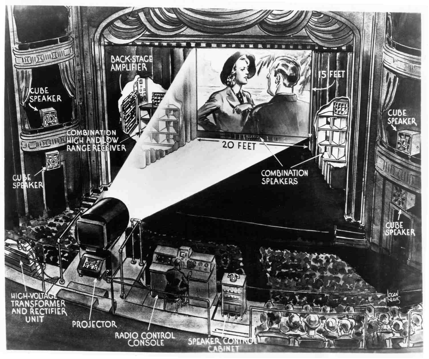The Conventional Wisdom
The conventional wisdom at this point indicates that digital cinema in the theater will involve a system that includes a projection device, a system to decompress the movie file, some sort of local storage system (probably using hard disks) and a method for delivering the movies to the venue. The whole thing will be protected by sophisticated security and encryption systems which will eliminate the possibility movie piracy (or at least make it highly inconvenient for the pirates.) In addition, the system will be absolutely reliable, robust, and easily maintained and controlled by the theater chains’ existing personnel. It will indeed be a wonderful thing.
The movies themselves will be produced as they are today, although this continues to evolve as well. Eventually films may be produced entirely in the digital domain and celluloid need never be involved. But for the purposes of a digital cinema discussion, it doesn’t matter whether the movie was shot on a borrowed 16mm camera, a consumer camcorder or with a major cinematographer behind a million dollars worth of cameras and lenses. The film will be finished and converted into a digital master either through a telecine process or some digital-to-digital process. This digital cinema master will then be compressed by a system that will reduce the file size by several orders of magnitude. The compression is necessary to make it cost effective and practical to move the compressed movie file around to thousands of theaters. Compression isn’t necessarily an evil thing and a properly designed compression system will produce pictures that are virtually indistinguishable from the original.
In addition to all of this, a digital cinema system might allow exhibitors to show live events, including pay-per-view programs like fights, NASCAR races or professional wrestling. The system might provide venues for multi-player high tech video games. Presumably, promoting these types of events might prove to be more profitable than showing feature films, since the movie theaters might have to share less box office revenue with the software provider than in the case of feature films.
Digital cinema systems should substantially reduce the incremental cost of distributing movies, making it more attractive for filmmakers, including independent studios, to distribute “smaller” films to a larger audience. The experience of the “Blair Witch Project” is still fresh on everyone’s mind; what if such a movie could have been distributed at a cost similar to its production costs? Another idea is to use digital cinema to put restored classic films into wider release. These are all good ideas and might help the exhibitors survive and grow in the coming years. It’s even possible that the studios will get on board with these alternative uses for the theaters, since many of them either own, are owned by, or in alliance with the independent studios, games companies and events promoters whose software will be shown on all of those digital screens.
